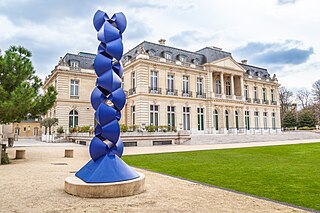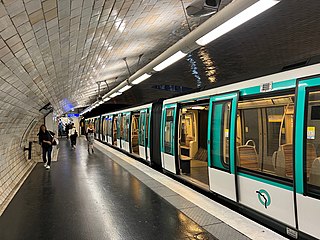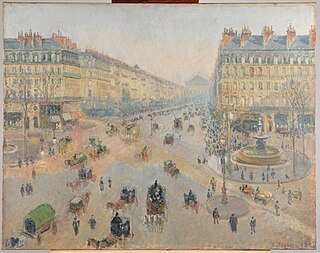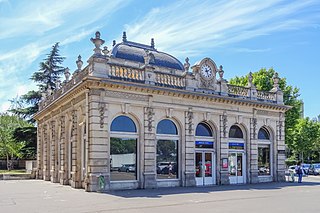
The Place Charles de Gaulle, historically known as the Place de l'Étoile, is a large road junction in Paris, France, the meeting point of twelve straight avenues including the Champs-Élysées. It was renamed in 1970, following the death of President Charles de Gaulle. It is still often referred to by its original name; the nearby Métro and RER station retains the designation Charles de Gaulle–Étoile. Paris's Axe historique cuts through the Arc de Triomphe, which stands at the centre of the Place Charles de Gaulle.

The 16th arrondissement of Paris is the westernmost of the 20 arrondissements of Paris, the capital city of France. Located on its Right Bank, it is adjacent to the 17th and 8th arrondissements to the northeast, as well as to the suburb of Boulogne-Billancourt, Hauts-de-Seine to the southwest. Opposite the Seine are the 7th and 15th arrondissements.

Cassel is a commune in the Nord department in northern France. Built on a prominent hill overlooking French Flanders, the town has existed since Roman times. It was developed by the Romans into an important urban centre and was the focus of a network of roads, which are still in use today, that converge on the hill. After the fall of the Roman Empire, Cassel became an important fortified stronghold for the rulers of Flanders which was repeatedly fought over before finally being annexed to France in the 17th century. It was the headquarters of Marshal Ferdinand Foch during part of the First World War. In 1940, during the German invasion of France, Cassel was the scene of a fierce three-day battle between British forces and German forces which resulted in much of the town being destroyed.
84 Avenue Foch was the Parisian headquarters of the Sicherheitsdienst (SD), the counter-intelligence branch of the SS during the German occupation of Paris in World War II.

The Exposition Universelle of 1878, better known in English as the 1878 Paris Exposition, was a world's fair held in Paris, France, from 1 May to 10 November 1878, to celebrate the recovery of France after the 1870–71 Franco-Prussian War. It was the third of ten major expositions held in the city between 1855 and 1937.

The Trocadéro, site of the Palais de Chaillot, is an area of Paris, France, in the 16th arrondissement, across the Seine from the Eiffel Tower. It is also the name of the 1878 Trocadéro Palace which was demolished in 1937 to make way for the Palais de Chaillot. The hill of the Trocadéro is the hill of Chaillot, a former village.

Porte Dauphine is the western terminus of Line 2 of the Paris Métro. It is situated in the 16th arrondissement. Avenue Foch station, served by the RER C line, is located nearby, as is Paris Dauphine University.

Trocadéro is a station on Line 6 and Line 9 of the Paris Métro in the 16th arrondissement. It serves and is named after the Place du Trocadéro.

The Avenue Foch is an avenue in the 16th arrondissement of Paris, France, named after World War I Marshal Ferdinand Foch in 1929. It was previously known as the Avenue du Bois de Boulogne. It is one of the most prestigious streets in Paris, as well as one of the most expensive addresses in the world, home to many grand city palaces, including ones belonging to the Onassis and Rothschild families. The Rothschilds once owned numbers 19–21.

The Palais de Chaillot is a building at the top of the Chaillot hill in the Trocadéro area in the 16th arrondissement of Paris, France.

The Avenue d'Iéna is a tree-lined avenue in the 16th arrondissement of Paris, running from the Trocadéro to the Place de l'Étoile. Passing through the Place d'Iéna, the Place de l'Amiral de Grasse, the Place de l'Uruguay and the Place Richard de Coudenhove Kalergi on the way. It is named after the neighbouring bridge across the Seine, the Pont d'Iéna. It has a length of 1,150 metres (0.71 mi) and an average width of 35 metres (115 ft).

Haussmann's renovation of Paris was a vast public works programme commissioned by French Emperor Napoleon III and directed by his prefect of the Seine, Georges-Eugène Haussmann, between 1853 and 1870. It included the demolition of medieval neighbourhoods that were deemed overcrowded and unhealthy by officials at the time, the building of wide avenues, new parks and squares, the annexation of the suburbs surrounding Paris, and the construction of new sewers, fountains and aqueducts. Haussmann's work was met with fierce opposition, and he was dismissed by Napoleon III in 1870. Work on his projects continued until 1927. The street plan and distinctive appearance of the centre of Paris today are largely the result of Haussmann's renovation.

The Musée national des Monuments Français is today a museum of plaster casts of French monuments located in the Palais de Chaillot, 1, place du Trocadéro et du 11 Novembre, Paris, France. It now forms part of the Cité de l'Architecture et du Patrimoine, and is open daily except Tuesday. An admission fee is charged.

Avenue Foch station is a station in the Paris express suburban rail system, the RER. It is in the 16th arrondissement of Paris. It had previous been called Avenue du Bois de Boulogne as part of the Auteuil line, but was renamed following the change to the road itself. The station was once a "sunken" station, meaning that it was not covered.

The Avenue de Wagram is a street in the 8th and 17th arrondissements of Paris, extending from the Place de Wagram to the Place Charles de Gaulle. It is 1.5 kilometres (0.93 mi) long and 36 metres (118 ft) wide, and is divided into two sections by the Place des Ternes. It was renamed on 2 March 1864 after Napoleon's 1809 victory at the Battle of Wagram; the section between the Avenue des Ternes and the Place de l'Étoile was formerly known as the Boulevard de l'Étoile or Boulevard de Bezons and the section between the Avenue des Ternes and the Place de Wagram, as Route départementale n°6.

The Avenue Henri-Martin is an avenue in the 16th arrondissement of Paris, named after the French historian Henri Martin (1810–1883), onetime mayor of the 16th arrondissement.

UNESCO Headquarters, or Maison de l'UNESCO, is a building inaugurated on 3 November 1958 at number 7 Place de Fontenoy in Paris, France, to serve as the headquarters for the United Nations Educational, Scientific and Cultural Organization (UNESCO). It is a building that can be visited freely.

The Jardins du Trocadéro is a public space in the 16th arrondissement of Paris, France. It is bounded to the northwest by the wings of the Palais de Chaillot and to the southeast by the Seine and the Pont d'Iéna at the Place de Varsovie, with the Eiffel Tower on the opposite bank of the Seine.
The Avenue d'Eylau is a two-way street in Paris' 16th arrondissement. It connects the Place du Trocadéro-et-du-11-Novembre and the Place de Mexico, 300 metres to the north-west. It is named after Napoleon's victory at the Battle of Eylau in 1807.

















